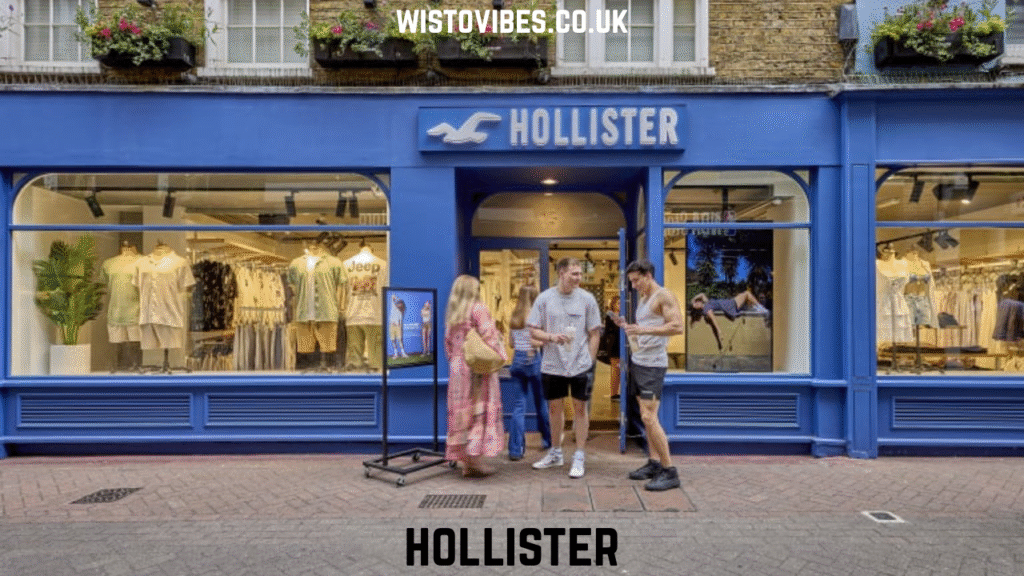Hollister is more than just a clothing brand; it is an entire lifestyle crafted around the essence of Southern California’s beach-inspired culture. Launched as a subsidiary of Abercrombie & Fitch, Hollister quickly developed its unique identity by catering to teenagers and young adults who are drawn to casual yet stylish clothing. The name itself evokes thoughts of surfboards, sandy beaches, and a laid-back coastal lifestyle. Unlike traditional fashion labels that primarily focus on clothing as a product, Hollister built its brand around the experience of youth culture and leisure. Stores, advertising campaigns, and the very atmosphere surrounding the brand were designed to immerse customers in a beachside California dream.
The Origins of Hollister

Hollister was introduced in the year 2000 by Abercrombie & Fitch, with a clear vision to capture a younger market segment. While Abercrombie targeted older teens and adults, Hollister was strategically created to provide a more affordable option while keeping the same sense of aspirational lifestyle. The idea was to transport customers to a fictional surf town in California, where every day revolved around the ocean, waves, and friendships built along the shore. This origin story, though constructed, became central to its identity. By tying itself to an imaginative location, Hollister set itself apart from other retailers and created an environment where teenagers could feel part of a larger community defined by fun, freedom, and sun-soaked adventures.
The Hollister Store Experience
Walking into a Hollister store is unlike entering a typical clothing shop. From the beginning, Hollister focused on creating immersive experiences. Stores were intentionally designed to look like surf shacks, complete with dim lighting, wooden shutters, the scent of their signature cologne, and upbeat music. This sensory approach made shopping at Hollister more than a task; it became an event, a moment of entertainment, and a chance to be part of a dreamlike setting. The dim lighting and casual atmosphere encouraged customers to browse slowly, feel relaxed, and spend more time engaging with the products. Hollister deliberately aimed to sell not just clothes but an overall vibe of youthful adventure.
Hollister’s Iconic Clothing Style

The clothing at Hollister represents a blend of casual comfort and subtle style. Their collections often feature graphic tees, hoodies, distressed jeans, flannels, swimwear, and beach-inspired accessories. Everything about the brand reflects relaxation and effortless cool, aligning with the spirit of surf culture. Unlike formal or sophisticated attire, Hollister leans heavily toward pieces that young people can wear every day, whether lounging at school, hanging out with friends, or going to the beach. Comfort and relatability became their fashion signature, making Hollister a go-to choice for teenagers who wanted to dress stylishly without appearing too polished.
Marketing and Youth Appeal
The success of Hollister has been largely tied to its marketing strategies. The brand initially positioned itself as aspirational but still attainable, making young people believe they were buying into an entire lifestyle rather than just clothing. Advertising campaigns featured beach backdrops, carefree models, and messages of fun, togetherness, and adventure. By directly appealing to teenage emotions and desires for belonging, Hollister built a strong connection with its audience. This marketing appeal was further reinforced by in-store models and greeters who embodied the brand’s image, ensuring that every customer encounter felt like part of the story.
Hollister and the California Dream

At the heart of Hollister is its association with the California dream—a life of endless sunshine, surfing, and effortless beauty. This dream-like image resonates not only with American teenagers but also with young people around the globe who associate California with freedom and excitement. Hollister successfully took this regional lifestyle and transformed it into an international aspiration. Even customers who had never been to California could experience it through the brand, making Hollister a bridge between reality and fantasy.
Hollister’s Expansion into Global Markets
Though its identity is firmly rooted in California culture, Hollister has expanded far beyond American borders. Stores can now be found in major cities worldwide, from Europe to Asia, where the fascination with American surf and beach culture continues to thrive. Global expansion was carefully executed to retain the same atmosphere, ensuring that the sense of authenticity was never lost. International customers embraced Hollister as a way of connecting with a lifestyle that felt both foreign and desirable. The global presence demonstrates how universal themes of youth, fun, and freedom resonate regardless of geography.
The Role of Branding in Hollister’s Success
Hollister’s brand identity has been a critical factor in its success. Every detail, from the iconic seagull logo to the consistent surf-inspired imagery, reinforces the company’s narrative. Branding has gone beyond clothing tags, embedding itself into the architecture of stores, the scent associated with the brand, and even the playlists that define its ambiance. Hollister’s ability to weave a consistent narrative through every touchpoint demonstrates the power of branding in creating lasting impressions. By maintaining consistency, the company ensured that customers associated Hollister with more than fashion—it became synonymous with a lifestyle.
Challenges Faced by Hollister
Like many retail brands, Hollister has faced challenges over the years, particularly with changing fashion trends and consumer expectations. As competitors introduced faster and cheaper options, Hollister had to adapt while staying true to its identity. The brand also faced criticism for being overly exclusive in its earlier years, creating barriers for certain customers. These challenges forced Hollister to rethink its strategies, become more inclusive, and modernize its appeal. By listening to feedback and adjusting its approach, Hollister managed to sustain relevance in an evolving retail market.
Hollister’s Influence on Youth Culture
Few brands have had as much influence on youth culture as Hollister. For many teenagers, wearing Hollister represented a rite of passage, a way of expressing identity and belonging. The clothes became symbols of friendship, group identity, and social acceptance. Beyond fashion, Hollister shaped how young people envisioned the “cool” lifestyle, tying together elements of music, attitude, and adventure. The cultural impact extended beyond wardrobes into conversations, social groups, and aspirations, making Hollister a defining force in youth expression.
Digital Transformation of Hollister
As shopping habits shifted toward digital platforms, Hollister embraced e-commerce and social media to stay connected with its audience. The brand created engaging online campaigns, leveraged influencers, and built interactive websites to replicate the immersive experience of its stores in a digital format. This digital transformation allowed Hollister to reach audiences who could not visit physical stores while maintaining its lifestyle-oriented branding. The ability to transition into the digital era ensured its survival and continued growth in a highly competitive market.
Hollister and Inclusivity Efforts
In recent years, Hollister has worked hard to redefine itself as an inclusive brand. Early criticism about exclusivity and narrow beauty standards prompted the company to expand its sizing, diversify its marketing campaigns, and showcase models of various backgrounds. Inclusivity has become a key part of Hollister’s modern identity, allowing the brand to connect with a broader customer base. These efforts reflect the changing demands of consumers who value representation and authenticity in the brands they support.
The Hollister Lifestyle Beyond Clothing
Hollister has succeeded in creating a lifestyle brand that extends beyond just clothing. Accessories, fragrances, and even store environments all contribute to the overall experience. By selling fragrances like their popular colognes and perfumes, Hollister gave customers another way to immerse themselves in the lifestyle. Every aspect of the brand—whether it’s a hoodie, a bottle of perfume, or even the music in the store—serves as a reminder of the Hollister lifestyle, which emphasizes relaxation, fun, and youthfulness.
Hollister in Pop Culture
Hollister’s popularity has made it a staple in pop culture references, especially during the 2000s and 2010s. Its logo and style became recognizable symbols of teenage fashion during this period. Whether appearing in music, film, or social media posts, Hollister often represented an aesthetic associated with youthful rebellion, carefree spirit, and aspiration. This cultural visibility contributed to its long-lasting popularity and gave it a distinct position among youth-focused brands.
The Future of Hollister
The future of Hollister lies in balancing tradition with innovation. While the brand will always be tied to its California surf culture identity, it must continue evolving to meet new consumer expectations. This involves expanding sustainable practices, offering versatile fashion, and embracing new technologies for both in-store and online experiences. By blending its timeless lifestyle appeal with modern values, Hollister has the potential to continue influencing new generations.
Hollister and Sustainability
One of the most pressing topics in modern fashion is sustainability, and Hollister has taken steps to address this issue. From introducing eco-friendly materials to reevaluating production methods, the brand has acknowledged its responsibility toward environmental concerns. Young consumers are increasingly prioritizing sustainable fashion, and Hollister’s efforts to align with these values strengthen its position in a changing industry. Sustainability not only ensures relevance but also builds trust among conscious shoppers.
Why Hollister Continues to Stand Out
Hollister continues to stand out because it is more than clothing; it is an identity, an aspiration, and a lifestyle that speaks directly to youth. Its consistent focus on creating experiences rather than just selling apparel has given it longevity in a crowded marketplace. While trends may change, the emotional connection Hollister has built ensures that it remains a brand associated with fond memories and youthful ideals. Its ability to adapt while keeping the essence of its California dream intact is what makes Hollister remarkable.
Hollister’s Connection with Customers
At the heart of Hollister’s strength is its deep connection with customers. It isn’t just about buying a shirt or hoodie—it’s about feeling a part of something bigger. The emotional bond created through branding, store experiences, and consistent storytelling has allowed Hollister to maintain loyalty. Customers are not just purchasing fashion; they are embracing a vision of themselves tied to adventure, confidence, and community. This connection continues to define Hollister as more than a retailer.
Conclusion
Hollister has managed to transform itself from a simple fashion retailer into an iconic lifestyle brand that resonates with young people across the globe. Its origins rooted in surf culture, its immersive store experiences, and its ability to adapt to new challenges have kept it relevant for decades. As Hollister continues to evolve, it embraces inclusivity, sustainability, and digital transformation while holding on to its core identity. This balance ensures that Hollister remains a timeless part of youth fashion and culture.
FAQs about Hollister
Q1: What is Hollister best known for?
Hollister is best known for its California-inspired clothing, casual styles, and immersive store experiences that reflect surf and beach culture.
Q2: Who owns Hollister?
Hollister is owned by Abercrombie & Fitch Co., which launched the brand in 2000 to target a younger audience.
Q3: Why do people like Hollister clothing?
People enjoy Hollister clothing because it combines comfort, casual style, and an association with a relaxed, adventurous lifestyle.
Q4: Does Hollister sell products other than clothing?
Yes, Hollister also sells fragrances, accessories, and lifestyle products that complement its fashion lines.
Q5: Is Hollister available worldwide?
Yes, Hollister has expanded globally with stores in North America, Europe, Asia, and other regions, bringing its California dream to international customers.
Read More: Betway A Comprehensive Look at the Global Betting Platform




